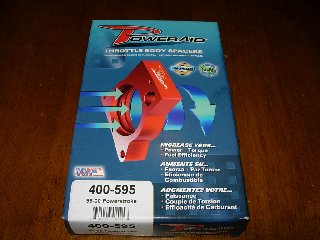
That I take my vehicles to a mechanic, even for minor problems, makes me spoiled in some respects. Though I have disciplined myself to change wiper blades, fuses and light bulbs. Nonetheless, when I looked the throttle body spacer over, I took up the challenge to install the unit myself.
This isn't a hard one. PowerAid claims you can install this in half an hour. It took me half that long — including the time it took to repair a damaged electrical connection I discovered during the installation (unrelated).
By the way, this installation is in a 2000 7.3L PSD F350 Dually. But most other installations are going to be similar, if not the same. [BTW: If you're driving something else, it don't make you bad — but you are missing out on a great ride!!]
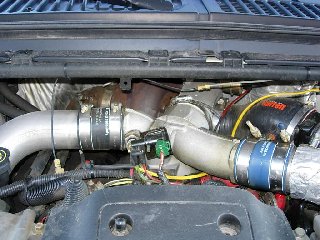
Here's where the action is going to take place. There is a yoke that comes from the turbo; the tube to the right, you will see is wrapped in a heat foil. That is because it is hot!! It leads from the turbo to the intercooler. The tube to the left returns from the intercooler bringing cool air back to the engine. This is the side you want to install the throttle body spacer.
BUT FIRST — we are going to disconnect the negative cables from the batteries — both batteries. Negative cable: the black cable (positive is usually red) and they are connected to the "-" (minus) side of the battery. [I'm making this simple for the sake of those who have never worked under the hood before — and this job is sooo simple anyone can do it, as long as they make certain to do everything just the way it is described here and in the instructions.]
I was curious why the battery cables had to be disconnected. It didn't seem to me the throttle body spacer was supposed to complete any electrical circuit, nor could I see how this would disrupt any electrical circuit — so I called the good folks at AirAid. The tech explained to me the purpose was to erase the short term memory in the computer. By installing the throttle body spacer, you are changing the airflow and this will confuse the mass airflow sensor. However, what he told me, you won't find in the instructions — in order for this to work, you need to leave the battery cables disconnected for at least one-hour.
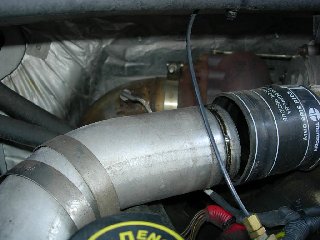
At this point, the formed intake tube is removed from the rubber sleeve that connects to the intake manifold. I removed both clamps from the sleeve, however, it became apparent the throttle body spacer could be installed without removing the sleeve from the intake manifold. Although, the instructions say to remove the hose, I think it was easier to leave the manifold side intact. After all, the purpose is to install the throttle body spacer so that it inserts itself into both the formed intake tube and the manifold tube. Removing the sleeve completely and placing the spacer in the middle is only going to make lining up the spacer that much harder.
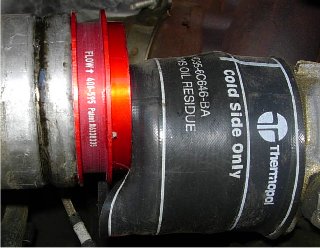
The instructions say to install a small amount of grease on the edge of the spacer to facilitate installation. I couldn't find any grease (that's the cost of having a son who is always working on something), so I used oil. But the spacer would have installed easily without.
Before you install the throttle body spacer, it is important the spacer is facing the right direction!!! On the top of the spacer is an arrow indicating the direction of the airflow. Make sure the arrow points toward the intake manifold. In other words, the air flows from the intercooler to the intake manifold (or the engine).
In this photo, you see the spacer is perfectly seated in the formed intake tube. You want it to seat this same way into the intake manifold tube. I took it out of the formed tube, placed it in the intake manifold tube, tested the fit, felt inside the spacer for the connection with the intake manifold and in every way looked at what that connection looked like so that I would know I had a positive fit when it was hidden by the rubber sleeve.
I put the spacer back into the formed intake tube and worked both as a unit through the rubber connecting hose. I listened for a positive connection, felt for evidence and checked measurements.
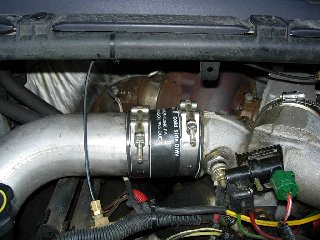
If you are with me up to this point, go ahead and place the clamp over the hose on the intake manifold side. Go ahead and tighten it all the way — remember, you didn't need to remove it in the first place.
Clamping the left side, or the formed intake tube is a little trickier — but not hard. As you are tightening the clamp, you will notice the formed intake tube wants to slide out of the rubber connection hose. I used my spare arm (always keep one on hand) to force and hold the tube in place (painful, but short lived). Still, the formed tube managed to slide 3/32" out of the sleeve. After several attempts (multiple sessions of self-inflicted pain) only to have the same results, I called the tech at AirAid and he advised me that the connect would still work in this fashion as there was no where else for the air to go, anyway. I was satisfied with that.
After waiting an hour to re-connect the battery cables, I was ready to fire this baby up! LOVED what I heard — three whistles; one from the AFE air intake, one from the Garrett Turbo and the deep whistle from the throttle body spacer.
Whistles are fine, but the truck has to move too. So I took it for a spin, I always forget to get out of my neighborhood before I throttle it, but I got to think I'm providing these retired folk with some type of entertainment. I remember the time I filled the front yard of the house on the corner with thick black smoke. I was surprised I never heard anything from him, but then, he moved out the next week. Anyway, I laid down on the throttle and she moved. You know, a throttle body spacer is one of those elements that help but are not going to be the single reason for your increased performance. I will say this, the gain was small but noticeable. Noticed most in the response.
Definitely pleased with the product and the price is not too high for any budget.

